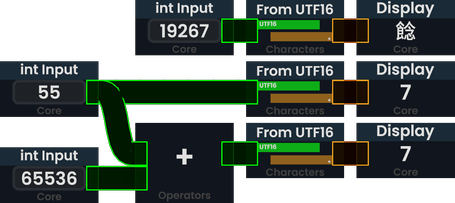m other way around |
m style & formatting |
||
| Line 12: | Line 12: | ||
|}} | |}} | ||
From UTF16 | The '''From UTF16''' node transforms a 16-bit Unicode codepoint to its corresponding character within the [https://en.wikipedia.org/wiki/Plane_(Unicode)#Basic_Multilingual_Plane Basic Multilingual Plane]. | ||
== Inputs == | == Inputs == | ||
=== UTF16 ([[Type: | === UTF16 ([[Type:int|int]]) === | ||
The Unicode codepoint, as decimal, to convert. This must reside within the Basic Multilingual Plane (<code>0x0000-0xFFFF</code>). The output will "wrap around" at every multiple of 65536, essentially having an implicit modulo. | The Unicode codepoint, as decimal, to convert. This must reside within the Basic Multilingual Plane (<code>0x0000-0xFFFF</code>). The output will "wrap around" at every multiple of 65536, essentially having an implicit modulo. | ||
| Line 22: | Line 22: | ||
== Outputs == | == Outputs == | ||
=== * ([[Type: | === * ([[Type:char|char]]) === | ||
The resulting converted character. | The resulting converted character. | ||
Latest revision as of 20:02, 3 June 2024
From UTF16
Characters
The From UTF16 node transforms a 16-bit Unicode codepoint to its corresponding character within the Basic Multilingual Plane.
Inputs
UTF16 (int)
The Unicode codepoint, as decimal, to convert. This must reside within the Basic Multilingual Plane (0x0000-0xFFFF). The output will "wrap around" at every multiple of 65536, essentially having an implicit modulo.
Outputs
* (char)
The resulting converted character.
Examples
-
Example of using From UTF16 in some ProtoFlux code, showcasing converting both ASCII and non-ASCII characters, as well as the wraparound behavior after 65536.
